Toyota bZ4X Owner's Manual: Toyota bZ4X Rear Camera Detection (RCD) for Pedestrian Safety
When your 2025 Toyota bZ4X is in reverse gear, the Rear Camera Detection (RCD) function is designed to detect pedestrians who are in the area directly behind the vehicle. This system acts as an extra layer of awareness to help you maneuver safely.
If the RCD system detects a pedestrian in the designated detection zone, it will alert you with an audible buzzer sound. Additionally, a visual icon will be displayed on the multimedia display screen, providing a clear indication to the driver about the presence of the pedestrian.
WARNING - Important Safety Information Regarding the RCD System
Limitations of the System
It is crucial to understand that the recognition and control capabilities of the Rear Camera Detection system in your 2025 Toyota bZ4X are limited. This technology is intended as an aid and not a replacement for attentive driving.
As the driver, you must always maintain focus on your surroundings and operate the vehicle safely. Never rely solely on the RCD system; always be responsible and fully aware of the traffic and environment around your Toyota bZ4X.
Ensuring Proper Operation of Your RCD System
To ensure the Rear Camera Detection system on your 2025 Toyota bZ4X can function effectively and safely, please adhere to the following guidelines. Failure to do so could compromise the system's performance and potentially lead to an accident.
- Always keep the rear camera lens clean. Use a soft, non-abrasive cloth to gently wipe away any dirt, dust, or debris without causing damage to the camera unit.
- Avoid installing any aftermarket electronic parts, such as illuminated license plate frames or additional fog lamps, in the immediate vicinity of the rear camera. These non-standard components could potentially interfere with the camera's field of view or image quality.
- Protect the rear camera area from strong impacts. If the camera or its surrounding area is subjected to a significant impact, it's essential to have your 2025 Toyota bZ4X inspected by an authorized Toyota dealer to ensure the camera's alignment and functionality have not been affected.
- Do not attempt to disassemble, modify, or paint the rear camera unit. Any alterations to the camera could impair its ability to function correctly.
- Refrain from attaching any accessories or stickers directly to the camera lens or its housing. These could obstruct the camera's view or interfere with its operation.
- Do not install any aftermarket protection parts, such as bumper trim pieces not specifically designed for your 2025 Toyota bZ4X, to the rear bumper as these could potentially block the camera's view.
- Maintain the correct tire air pressure as specified in your owner's manual. Uneven tire pressure can affect the vehicle's stance and potentially the camera's angle.
- Always ensure that the back door or liftgate of your 2025 Toyota bZ4X is completely closed when backing up. An improperly closed door could obstruct the camera's view.
Conditions Under Which the RCD Function May Be Turned Off or Not Operate Properly
In the following situations, the Rear Camera Detection system on your 2025 Toyota bZ4X may be automatically turned off or might not function as intended. Relying on the system in these circumstances could be dangerous and increase the risk of an accident.
- If any of the aforementioned guidelines for proper system operation are not observed (e.g., a dirty camera lens, aftermarket parts installed near the camera, etc.).
- If the suspension system of your 2025 Toyota bZ4X has been modified with non-genuine parts. Alterations to the suspension can change the vehicle's ride height and affect the camera's angle and therefore its detection capabilities.
System component
Location of the rear camera
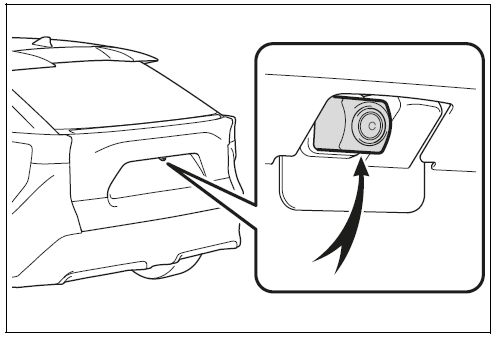
RCD display
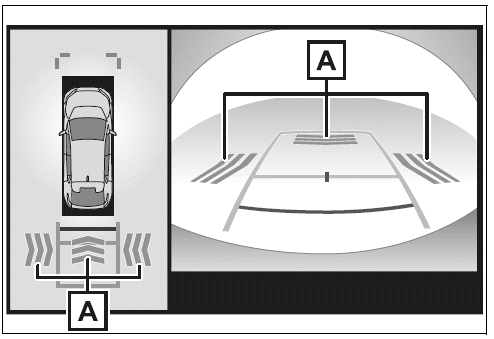
- Pedestrian detection icon
Displayed automatically when a
pedestrian is detected behind the
vehicle.
Turning the RCD function
on/off
The RCD function can be
enabled/disabled through a customize
setting.
When the RCD function is disabled,
the driving assist information indicator
illuminates, and a
message is displayed on the multiinformation
display.
Each time the power switch is
turned off then changed to ON, the
RCD function will be enabled automatically.
When a pedestrian is detected
If a pedestrian is in the area
behind the vehicle or if the rear
camera detected that a pedestrian
is approaching the vehicle
from behind, the system urges
caution from the driver by sounding the buzzer and displaying
the detection of a pedestrian
on the multimedia display
as follows:
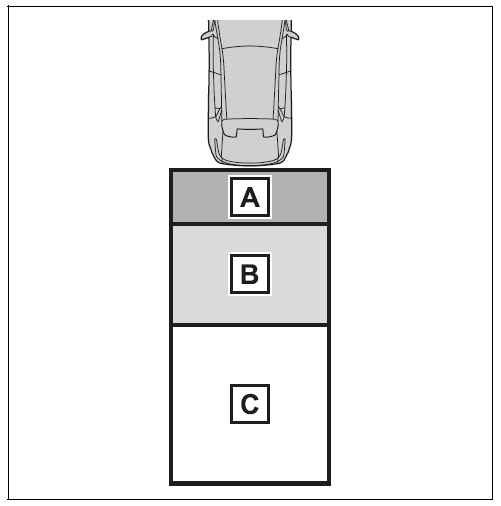
- If a pedestrian is detected in
area (A)
Buzzer: Sounds repeatedly
Pedestrian detection icon:
Blinks
- If a pedestrian is detected in
area (B)
Buzzer (When the vehicle is
stationary): Sounds 3 times
Buzzer (When the vehicle is
backing up, when a pedestrian
approaches the rear of
the vehicle): Sounds repeatedly
Pedestrian detection icon:
Blinks
- If the system determines that
your vehicle may collide with
a pedestrian in area (C)
Buzzer: Sounds repeatedly
Pedestrian detection icon: Blinks
The rear camera detection function
is operational when
- The power switch is in ON.
- RCD function is on.
- The shift position is in R.
- Advanced Park is not operating.
Setting the buzzer volume
The buzzer volume of the intuitive
parking assist, RCTA, and RCD can
all be changed at once from the customize
settings
Muting a buzzer temporarily
When an object is detected, the
temporary mute switch is displayed
on the multimedia display. Select
the switch to mute a buzzer of the
intuitive parking assist, RCTA, and
RCD all together.
Mute will be automatically canceled
in the following situations:
- When the shift position is
changed.
- When the vehicle speed exceeds
a certain speed.
- When there is a malfunction in a
sensor or the system is temporarily
unavailable.
- When the operating function is
disabled manually.
- When the power switch is turned
off.
Situations in Which the 2025 Toyota bZ4X Rear Camera Detection System May Not Operate Properly
The rear camera detection function in your 2025 Toyota bZ4X relies on visual data, and its ability to accurately detect pedestrians can be compromised under certain circumstances. Some pedestrians or situations that might prevent the system from operating correctly include:
- Pedestrians who are bending forward or squatting, as their profile might be too low or their shape might not be recognized as a typical human form.
- Pedestrians who are lying down, as they may be below the camera's typical field of view for detection.
- Pedestrians who are running, as their rapid movement might not be processed effectively by the system's detection algorithms.
- Pedestrians who suddenly appear from the shadow of the vehicle or a nearby building, as the sudden change in lighting or obstruction might prevent immediate recognition.
- Pedestrians who are riding moving objects such as a bicycle or skateboard, as the system is primarily designed to detect individual pedestrians.
- Pedestrians wearing oversized clothing such as a raincoat or a long skirt, which can obscure their body's silhouette and make them harder for the system to identify.
- Pedestrians whose body is partially hidden by an object, such as a shopping cart, a stroller, or an umbrella, which can obstruct the camera's view of the entire person.
- Pedestrians who are obscured by darkness, such as at night or in very low-light conditions, as the camera's visibility is significantly reduced.
- In various environmental conditions, the rear camera detection function of your 2025 Toyota bZ4X might also be unable to properly detect pedestrians:
- When backing up in inclement weather such as heavy rain, snow, fog, or heavy mist, as the visibility for the camera is reduced by the weather conditions.
- If the camera lens is dirty due to mud, snow, road salt, or other debris, or if the lens is scratched, the image quality will be impaired, affecting detection.
- When a very bright light source, such as direct sunlight or the glare from another vehicle's headlights, shines directly into the rear camera lens, it can overwhelm the sensor and hinder detection.
- When backing up in a location where the surrounding brightness levels change suddenly and drastically, such as when moving from bright daylight into a dark garage or from a dark underground parking lot into bright sunlight, the camera sensor might take time to adjust.
- When backing up in consistently dim environments, such as during dusk or in an underground parking lot with minimal lighting, the lack of sufficient light can limit the camera's effectiveness.
- If the rear camera's physical position or direction has been deviated due to a collision, impact, or improper removal and reinstallation, its field of view and detection accuracy can be affected.
- When a towing hook or similar accessory is attached to the rear of your Toyota bZ4X, it might partially obstruct the camera's view or be misinterpreted by the system.
- When water droplets are present and flowing across the camera lens, they can distort the image and impair the system's ability to identify pedestrians.
- When the vehicle's height is significantly altered, such as when the front is raised or lowered due to heavy cargo or when on a very steep incline, the camera's angle and field of view can change.
- When tire chains are installed for winter driving or if an emergency tire puncture repair kit has been used, these might alter the vehicle's dynamics or slightly obstruct the camera's view.
- If any aftermarket electronic components, like a backlit license plate frame or additional fog lights not approved by Toyota, are installed near the rear camera, they could cause interference.
- If a non-genuine bumper protector or additional trim strip has been installed on the rear bumper, it might encroach into the camera's field of view.
- As noted before, when your vehicle is towing a trailer, the rear detection systems might not function optimally.
Situations in Which the 2025 Toyota bZ4X Rear Camera Detection System May Operate Unexpectedly
- Even when no pedestrians are actually present in the detection area behind your 2025 Toyota bZ4X, the system might sometimes detect certain objects and trigger an alert. These could include:
- Three-dimensional objects like poles, traffic cones, fences, or parked vehicles, which might be mistaken for a pedestrian's form.
- Moving objects such as other cars or motorcycles passing behind your vehicle.
- Objects moving towards your vehicle while you are backing up, such as flags waving in the wind or reflections from puddles, as well as airborne particles like smoke, steam, heavy rain, or snow.
- Complex road surfaces like cobblestone or gravel roads, tram rails, areas with road repairs, painted white lines, pedestrian crossings, or even a significant amount of fallen leaves on the road surface.
- Metal covers or gratings, such as those used for drainage ditches, which can sometimes produce reflections or patterns that the system interprets.
- Reflections of objects that appear in a puddle or on a wet road surface behind your vehicle.
- Strong shadows cast on the road surface, which can sometimes be misinterpreted as a solid object or pedestrian.
- There are also specific scenarios where the rear camera detection function in your 2025 Toyota bZ4X might issue an alert even if there is no pedestrian in the immediate vicinity:
- When backing up towards the roadside or a noticeable bump or elevation change on the road surface.
- When backing up towards a significant incline or decline.
- As mentioned earlier, when the vehicle's height is significantly altered due to loading or terrain.
- If non-approved aftermarket electronic parts are installed near the rear camera.
- If a non-genuine bumper protector or trim strip has been added to the rear bumper.
- If the rear camera's orientation has been changed due to an impact or improper installation.
- If a towing eyelet is attached to the rear of the vehicle.
- When a significant amount of water is flowing over the rear camera lens.
- If the camera lens is obstructed by dirt or snow-melting agents.
- If there is a flashing light source within the detection area, such as the emergency hazard lights of another vehicle.
- When tire chains are in use or if an emergency tire puncture repair kit has been applied.
- Again, when you are towing with your vehicle, the system's behavior might be affected.
- Finally, here are situations in which the rear camera detection function's alerts might be difficult to notice:
- The audible buzzer alert might be hard to hear if there is a lot of ambient noise in the surrounding environment or if the vehicle's audio system volume is set very high.
- In extreme cabin temperatures, either very hot or very cold, the multimedia display screen where the visual alert appears might not operate correctly, potentially making the alert difficult to see.
Understanding the various conditions and limitations of the Rear Camera Detection system in your 2025 Toyota bZ4X is crucial for using it responsibly and safely. This technology is intended to assist you, but it should never replace your own careful observation and judgment.
Toyota Parking Support Brake (PKSB) System
The Parking Support Brake (PKSB) is an advanced safety system designed to assist drivers, particularly when maneuvering at low speeds during parking. It functions by issuing warnings to the driver and, if necessary, automatically applying the brakes to help mitigate collision damage with detected obstacles.
PKSB System Operation Targets
The PKSB system on your vehicle is engineered to detect various types of obstacles, though the specific targets it monitors can depend on the particular system configuration:
- Parking Support Brake (Static Objects - Front and Rear): This function is designed to detect stationary objects located in front of or behind your vehicle, such as walls, poles, or other parked cars.
- Parking Support Brake (Moving Vehicles - Rear): This capability allows the system to detect vehicles approaching from behind while you are parking or maneuvering at low speeds.
- Parking Support Brake (Pedestrians - Rear) (If Equipped): If your vehicle is equipped with this enhanced feature, the PKSB system can also detect pedestrians located behind the vehicle.
- Parking Support Brake (Static Objects Around the Vehicle) (Vehicles with Advanced Park): In vehicles featuring the Advanced Park system, PKSB can extend its monitoring to static objects located around the entire periphery of the vehicle during automated parking maneuvers.
WARNING - Important Safety Precautions for the Parking Support Brake System
Do not become over-reliant on the Parking Support Brake system, as this could potentially lead to an accident. It is crucial to always actively monitor your surroundings while driving and parking.
The operational effectiveness of the PKSB system can be influenced by various factors, including the specific vehicle model, road conditions, and prevailing weather. In certain situations, the system may not function as expected or at all.
Please be aware that the detection capabilities of the sensors and radars that power the PKSB system have inherent limitations. They might not detect all types of obstacles or may have difficulty in certain environmental conditions.
Therefore, it is paramount to always drive and maneuver your vehicle while being fully aware of your surroundings and personally verifying safety.
- The driver bears the ultimate responsibility for safe driving practices. Always drive with caution and diligently observe your environment. The Parking Support Brake system is intended to provide assistance in reducing the severity of potential low-speed collisions. However, it is not a foolproof system and may not activate in all situations.
- The Parking Support Brake system is not designed to bring your vehicle to a complete stop from higher speeds. Furthermore, even if the system does initiate braking and brings the vehicle to a halt, this brake control will typically be released after approximately 2 seconds. It is essential for the driver to immediately take over braking by depressing the brake pedal if a complete and sustained stop is required.
- It is extremely dangerous to intentionally test the system's capabilities by deliberately driving towards obstacles such as walls. Never attempt to verify the PKSB system's operation in this manner, as it could result in vehicle damage or personal injury.
When to Disable the Parking Support Brake
In the following situations, it is recommended to disable the Parking Support Brake system as it might activate unnecessarily even when there is no actual risk of a collision:
- When the vehicle is undergoing inspection using equipment such as a chassis roller, chassis dynamometer, or free roller, as the stationary wheels might be misinterpreted by the sensors.
- When the vehicle is being loaded or unloaded onto a boat, truck, or other transport vessel, as the unusual angles and restraints might trigger the system.
- If the vehicle's suspension has been modified from the original factory specifications or if tires of a size other than those recommended are installed, as this can affect the sensor's calibration and readings.
- If the front or rear of the vehicle is significantly raised or lowered due to the weight of the load being carried, as this can alter the vehicle's pitch and affect sensor performance.
- When equipment such as a non-standard towing hook, transport hook, bumper protector, bumper trim, bicycle carrier, or a snow-removal device (snow plow) is installed near the sensors, as these might obstruct or interfere with their operation.
- When using automated car washing devices, as the brushes and water spray might be detected as obstacles.
- If the vehicle is not able to be driven in a stable manner, such as after being involved in an accident or if it is experiencing a mechanical malfunction that affects its stability or sensor readings.
- When the vehicle is being driven in a sporty manner involving rapid acceleration and braking, or when driving off-road on uneven terrain, as the system is primarily designed for low-speed parking maneuvers.
- If the tires are not inflated to the recommended pressure, as this can slightly affect the vehicle's ride height and sensor angles.
- When the tires are significantly worn, as this can alter the rolling circumference and potentially affect sensor readings.
- When tire chains, a compact spare tire, or an emergency tire puncture repair kit are in use, as these can change the vehicle's dynamics and might be detected by the sensors.
- When towing a trailer with the vehicle, as the trailer can introduce unusual reflections and angles that might trigger the system.
Precautions for the Suspension System
Avoid making any modifications to the vehicle's suspension. If the ride height or the vehicle's tilt is altered from the factory settings, the sensors that the Parking Support Brake system relies on may not be able to accurately detect objects, and the system's performance could be compromised, potentially leading to an accident.
Enabling and Disabling the Parking Support Brake
The Parking Support Brake function in your vehicle can be conveniently enabled or disabled through the customize settings menu, typically accessible via the vehicle's infotainment system.
When the PKSB system is disabled, a driving assist information indicator on the instrument panel will illuminate, and a corresponding message will be displayed on the multi-information display to inform you that the system is currently inactive.
If the system is manually switched to the OFF (disabled) state, it will remain off, and the PKSB function will not be automatically re-enabled the next time you start your vehicle. To reactivate the system, you will need to manually select the ON (enabled) option again through the customize settings menu.
(The system will remain off even if the power switch is turned to the ON position again after the vehicle has been completely turned off and restarted.)
Display and Buzzer for EV System Output Restriction Control and Brake Control
If the EV system output restriction control or the brake control of the Parking Support Brake system is activated, an audible buzzer will sound to alert the driver. Simultaneously, a message will be displayed on both the multimedia display and the multi-information display to provide specific details about the system's intervention.
Depending on the specific situation and the severity of the potential collision risk, the output restriction control might either limit the vehicle's acceleration or restrict the power output as much as possible to help reduce speed.
- EV system output restriction control is operating (acceleration restriction): In this mode, the system has detected an object and is limiting acceleration beyond a certain threshold.
Multimedia display: No specific warning displayed in some configurations.
Multi-information display: Typically shows a message like "Object Detected Acceleration Reduced".
Driving assist information indicator: Not illuminated in some cases.
Buzzer: Usually does not sound.
- EV system output restriction control is operating (output restricted as much as possible): The system has determined that a stronger intervention is necessary and is significantly limiting the vehicle's power output.
Multimedia display (vehicles with panoramic view monitor): May display a prominent "BRAKE!" warning.
Multi-information display: Typically shows "BRAKE!".
Driving assist information indicator: Not illuminated.
Buzzer: May sound a short beep.
- Brake control is operating: The system has assessed a high risk of collision and has automatically engaged the brakes to help avoid or mitigate the impact.
Multimedia display (vehicles with panoramic view monitor): May display a "BRAKE!" warning.
Multi-information display: Typically shows "BRAKE!".
Driving assist information indicator: Not illuminated.
Buzzer: May sound a short beep.
- Vehicle stopped by system operation: The vehicle has been brought to a complete stop by the Parking Support Brake system's brake control.
Multimedia display (vehicles with panoramic view monitor): May display "Press Brake Pedal".
Multi-information display: If the accelerator pedal is being pressed, it might show "Accelerator Pedal is Pressed Press Brake Pedal". If the accelerator is not depressed, it might simply display "Press Brake Pedal".
Driving assist information indicator: Typically illuminated.
Buzzer: May sound repeatedly as a reminder to the driver to take over.
The Parking Support Brake is a valuable driver assistance technology, but it is essential to remember that it is not a substitute for attentive and responsible parking.
System overview
If the Parking Support Brake
determines that a collision with a detected object or
pedestrian is
possible, the EV system output
will be restricted to restrain any
increase in the vehicle speed.
(EV system output restriction
control: See figure 2 below.)
Additionally, if the accelerator
pedal continues to be
depressed, the brakes will be
applied automatically to reduce
the vehicle speed. (Brake control:
See figure 3.)
- Figure 1: When the PKSB
(Parking Support Brake) is not
operating
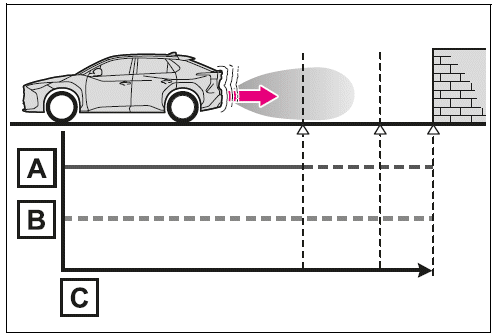
- EV system output
- Braking force
- Time
- Figure 2: When EV system
output restriction control operates
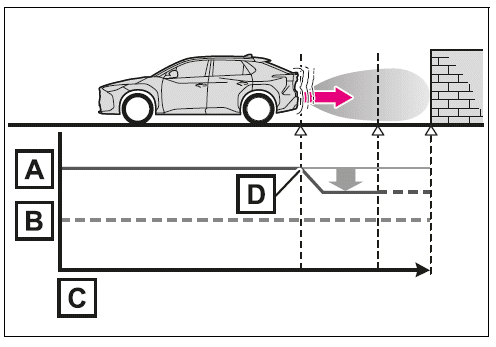
- EV system output
- Braking force
- Time
- EV system output restriction
control begins operating
(System determines that possibility
of collision with
detected object is high)
- Figure 3: When EV system
output restriction control and
brake control operates
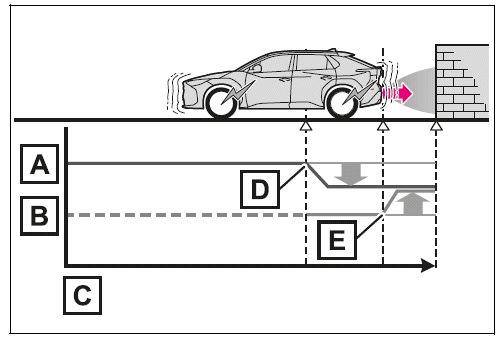
- EV system output
- Braking force
- Time
- EV system output restriction
control begins operating
(System determines that possibility
of collision with
detected object is high)
- Brake control begins operating
(System determines that
possibility of collision with
detected object is extremely
high)
What Happens If the Parking Support Brake in Your Vehicle Activates
If your vehicle comes to a stop due to the operation of the Parking Support Brake, the system will subsequently disengage, and the driving assist information indicator on your dashboard will illuminate. This indicates that the PKSB has been temporarily disabled after its intervention. Additionally, even when the PKSB initiates braking, the system's brake control will be automatically released after approximately 2 seconds to allow for the driver to take control.
Furthermore, the driver can manually override and cancel the brake control initiated by PKSB at any time by simply depressing the brake pedal. Following this, pressing the accelerator pedal will allow the vehicle to move forward or backward as intended.
How to Re-enable the Parking Support Brake
If the Parking Support Brake has been disabled following an activation, there are a couple of ways to re-enable the system. You can either manually turn the system back on through the customize settings menu in your vehicle's infotainment system, or you can simply turn the power switch of your vehicle off and then back to the ON position. This will typically reset and re-engage the PKSB system.
Moreover, the Parking Support Brake system is designed to automatically re-enable itself, and the driving assist information indicator will turn off, if any of the following conditions are met:
- The gear shift lever is moved to the 'P' (Park) position.
- The vehicle is driven without any objects being detected in its intended path of travel.
- The direction of the vehicle's movement is changed (e.g., from reversing to moving forward, or vice versa).
Understanding the PKSB Buzzer Feedback
Regardless of whether the intuitive parking assist feature is enabled in your vehicle, if the Parking Support Brake (PKSB) system is active, the vehicle's buzzer will sound to provide the driver with an indication of the approximate distance to a detected object. This audible feedback occurs when the brake control or the EV system output restriction control of the PKSB system is engaged, helping you to gauge the proximity of obstacles during parking maneuvers.
Remember, the Parking Support Brake is an aid designed to enhance parking safety, and it works best when used in conjunction with careful driver observation and awareness.
Parking Support Brake Function: Detecting Static Objects (Front, Rear, and Around Your 2025 Toyota bZ4X)
The Parking Support Brake (PKSB) system in your 2025 Toyota bZ4X is engineered with sensors that can detect static objects, such as walls or parked cars, located in the vehicle's intended direction of travel. If the system determines that a potential collision may occur, for instance, due to the vehicle suddenly moving forward as a result of unintentional accelerator pedal operation, moving in an unintended direction because the wrong gear has been selected, or during low-speed parking maneuvers, the PKSB will automatically engage. Its primary function in these situations is to help lessen the severity of the impact with the detected static object and reduce the resulting damage to your vehicle.
Examples of PKSB Operation (Static Objects in Front and Rear of Your Toyota bZ4X)
The Parking Support Brake function will activate in various scenarios, including the following, provided a static object is detected in the immediate path of your vehicle:
- When traveling at a low speed and the brake
pedal is not depressed, or is depressed late
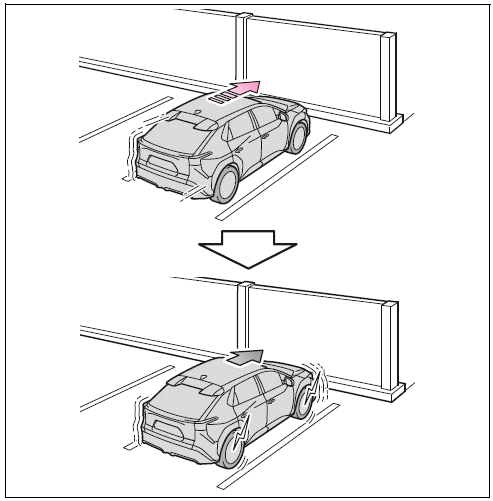
- When the accelerator pedal is depressed
excessively
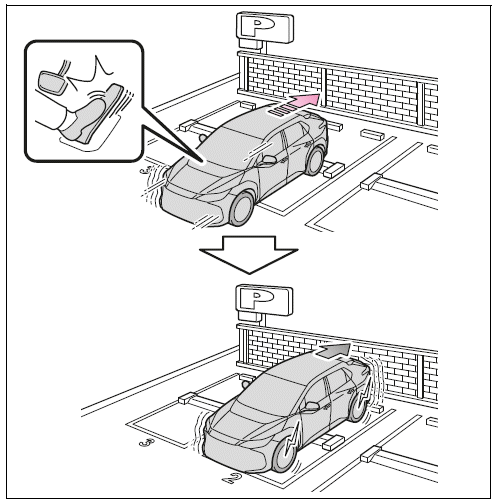
When the vehicle moves forward due to the
incorrect shift position being selected
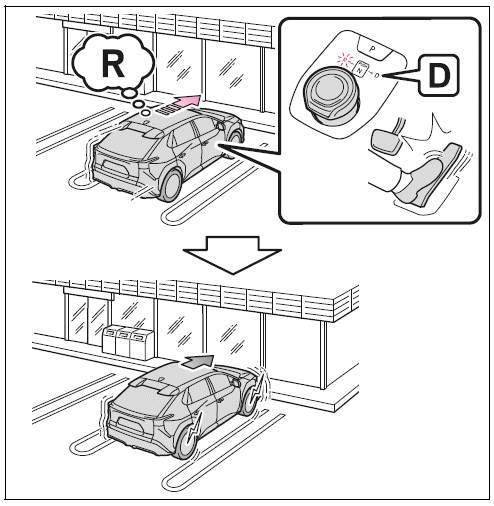
Examples of function operation (static objects around the vehicle) (Vehicles with Advanced
Park)
The system will operate in the
following situations when a stationary
object is detected in the
surrounding area.
When moving forward and a collision with a
stationary object on the inner side of a turn is likely
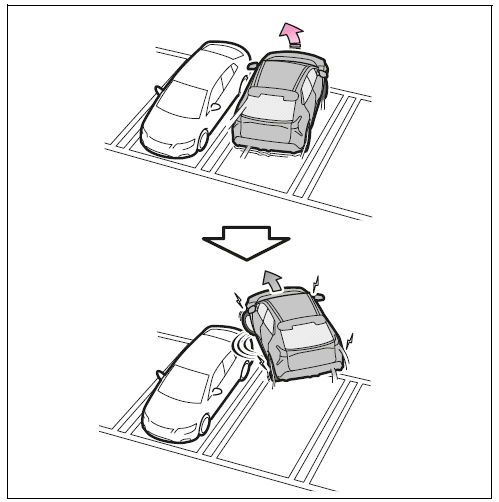
When reversing and a collision with a stationary object on the outer side of a turn is likely
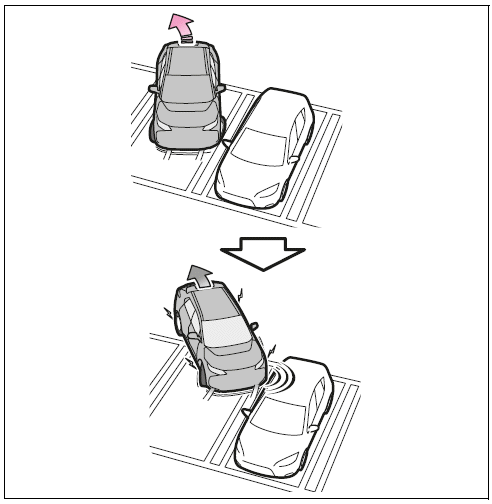
Types of sensors
WARNING
To ensure the system can operate properly
If the Parking Support Brake function operates unnecessarily, such as at a railroad crossing
Notes when washing the vehicle
When the Parking Support Brake Function Activates for Static Objects (Front and Rear of Your 2025 Toyota bZ4X)
The Parking Support Brake function for detecting static objects in front and rear of your 2025 Toyota bZ4X will typically activate when the driving assist information indicator is not illuminated, and all of the following conditions are met:
- EV System Output Restriction Control
- The Parking Support Brake system is enabled through the vehicle's settings.
- The vehicle's speed is approximately 9 mph (15 km/h) or less, indicating a low-speed maneuvering situation.
- A static object is detected in the vehicle's direction of travel, located approximately 6 to 13 feet (2 to 4 meters) away.
- The Parking Support Brake system determines that a stronger-than-normal brake operation is necessary to prevent a potential collision with the detected static object.
- Brake Control
- The EV system output restriction control is already active and operating to limit the vehicle's power.
- The Parking Support Brake system assesses that an immediate and more forceful brake operation is essential to avoid an imminent collision with the static object.
Activation of Parking Support Brake for Static Objects Around the Vehicle (2025 Toyota bZ4X with Advanced Park)
For 2025 Toyota bZ4X models equipped with Advanced Park, the Parking Support Brake function extends to detect static objects around the vehicle and will operate under the following additional conditions, in conjunction with the conditions mentioned for front and rear static object detection:
- Shortly after the EV system has been started, specifically if the vehicle has moved approximately 23.0 feet (7 meters) or less.
- When the gear shift is in the 'R' (Reverse) position.
- After the gear shift has been changed from 'R' (Reverse) to 'D' (Drive), and the vehicle has traveled approximately 23.0 feet (7 meters) or less.
When the Parking Support Brake Function for Static Objects (Front, Rear, and Around) Stops Operating
The Parking Support Brake function for static object detection will cease operation if any of the following conditions occur:
- EV System Output Restriction Control
- The Parking Support Brake system is manually disabled through the vehicle's settings.
- The system determines that a potential collision has been avoided or is no longer imminent, and normal brake operation is sufficient.
- The static object is no longer within the approximate range of 6 to 13 feet (2 to 4 meters) from the vehicle or is no longer in the vehicle's direct path of travel.
- Brake Control
- The Parking Support Brake system is disabled.
- Approximately 2 seconds have passed since the vehicle was brought to a stop by the system's brake control.
- The driver manually depresses the brake pedal after the vehicle has been stopped by the automatic brake control.
- The static object is no longer within the critical range or in the vehicle's path.
Detection Range Differences with Intuitive Parking Assist
It's important to note that the detection range of the Parking Support Brake function for static objects (both front/rear and around the vehicle) may differ from the detection range of the Intuitive Parking Assist system. Therefore, even if the Intuitive Parking Assist detects an object and provides a warning to the driver, the Parking Support Brake function might not necessarily initiate its braking or output restriction controls.
Situations Where the System Might Not Operate Properly
The Parking Support Brake system may face limitations in detecting static objects under various circumstances. For detailed information on these situations, please consult the owner's manual for your 2025 Toyota bZ4X.
Situations Where the System Might Operate Unexpectedly
Under certain conditions, the Parking Support Brake system might issue warnings or even activate braking even if there is no immediate risk of collision with a static object. For a comprehensive understanding of these scenarios, please refer to your vehicle's owner's manual.
Additional Situations for Static Objects Around the Vehicle (Advanced Park Models)
In addition to the limitations for detecting static objects in front and rear, models with Advanced Park might experience detection issues in specific scenarios. Please refer to the vehicle's manual for more information.
Detection of Objects Along the Sides of the Vehicle (Advanced Park Models)
The detection of objects along the sides of the vehicle by the Parking Support Brake system in models with Advanced Park has specific characteristics due to the use of side sensors and cameras. Please consult your owner's manual for detailed explanations.
Understanding the nuances of the Parking Support Brake system in your 2025 Toyota bZ4X is key to utilizing this technology effectively for enhanced parking safety.
The Rear Cross Traffic Alert (RCTA) function in your Hyundai utilizes the BSM rear side radar sensors, which are strategically installed behind the rear bumper. This innovative safety feature is desig ...
The Parking Support Brake system in your 2025 Toyota bZ4X is equipped with rear radar sensors designed to detect vehicles approaching from either the right or left while you are reversing. If the syst ...
Other articles:
Power (Ignition) Switch - Shift Control Instructions
Rotary Shifter
Operate the rotary shifter slowly and securely. To shift into neutral (N), press and hold the rotary shifter for a moment. To select reverse (R) or drive (D), press and hold the rotary shifter while turning it left or right according to the arrow shown on the shift position ind ...
For safety and security
The safety and security features of the Toyota bZ4X are thoughtfully engineered to provide maximum protection for you, your passengers, and your vehicle. This section offers detailed guidance on critical aspects such as child safety, including the proper use of child restraint systems and ISOFIX anc ...











 Hyundai Rear Cross Traffic Alert (RCTA) for Enhanced Backing Safety
Hyundai Rear Cross Traffic Alert (RCTA) for Enhanced Backing Safety Parking Support Brake Function: Detecting Moving Vehicles Approaching from the Rear of Your Vehicle
Parking Support Brake Function: Detecting Moving Vehicles Approaching from the Rear of Your Vehicle